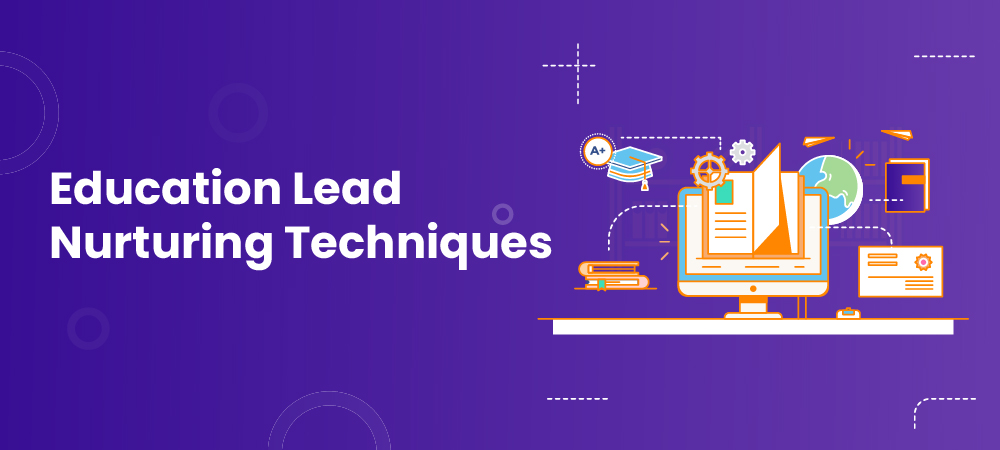Education lead nurturing does not mean sending personalized emails to everyone who visits your website. It is about building ties with users and fostering a good relationship between them and your brand.

The process of lead nurturing comprises a sequence of targeted and progressive communications with the prospect, understanding and acknowledging the prospect’s needs and providing ideal solutions for them. It is a process of accompanying the users along the buying journey and arousing their interest in your product.
What is Education Lead Nurturing?
The education cycle or rather learning cycle is a multi-phase process that often begins with surfing the internet. And that is where learners and educators encounter different websites, portals, and ads.
Now the first step of education lead nurturing, in this case, would be to hook them with the content on your website. The next step would be to obtain their preferences and contact information in lieu of your content delivered. And the subsequent process would be offering them relevant pieces of information from time to time.
Nurturing here means anticipating the needs of the users during different cycles of learning and providing ideal solutions for them. These solutions should be delivered even before they could ask for it. This would bind them with your brand and they will come in for more.
Four ways for effective education lead nurturing
Lead nurturing is the backbone of successful marketing and crucial for giving your product a voice. From videos to blog posts and from infographics to ad pop-ups, different organizations use different techniques to attract and engage users. EduGorilla, basically, relied on the following four techniques to raise and rear leads. Let’s check them out:

Count the raised hands
Not every user who visits your website will be your potential lead. According to studies, 50% of the leads in any system never make purchases. Thus, you need to track the behavior of your leads and identify the ones who are serious about purchases and are not merely gathering info. Score your leads in the order of their engagement and sort your priority list.
And once you find them, try to retain their interest in your product. And it could take anything from a month to a year. Send them auto-responses, shoot them personalized emails, and interact with them over the phone. Nurturing profiled leads leave a greater impact on the business as they are already interested in your offering. Such leads carry higher chances of conversion than the random, unprofiled ones.
Check for leakages in your sales funnel
Constant and routine analysis of the lead nurturing process is crucial for sustaining leads and avoiding their common fall-offs. The entire process of obtaining leads, nurturing them, and converting them to potential customers is lengthy and complex. Though not every lead contributes to sales, quite a lot of them drop off because of loopholes in the sales funnel.
To avoid that, the lead conversion process should be scrutinized and evaluated quite often. This helps in identifying the point where you lose leads. There can be lags on the part of your sales team, your content team, and even your tech team that might be creating disinterest for the users. Here, marketing analysis and monitoring of leads journey can help. It would let you resolve the issues beforehand and save your time, costs, and efforts.
It is your content that will feed the leads
The content you provide to your customers is what drives them towards you. So, you need to be very careful of the content you deploy at different stages of the sales funnel.
- At the gateway or entry-level, you need to generate appealing stuff that will drive the users to your website or landing page. This could be in the from blog posts, newsletters, or even videos
- The second stage is when you and the leads are aware of each other. It is the stage of building ties with the users and gaining their trust. Here you need to employ autoresponders and activity-based emails to scale lead attentiveness and personalization. At this stage, ‘How To’ content, product info, case studies, etc. will help
- The final stage of the sales funnel is the decisive point where the lead either converts into a customer or flees away. Here, you need to offer some convincing content so that they stay back with you. The quality content for such levels includes testimonials and reviews. A strong follow up by the sales team is also necessary at this point to persuade the customers
Define a set protocol for interacting with your leads
You should never become over-fastidious in the lead conversion process. While communication and follow-ups are a necessary precursor for sustaining and nurturing leads, over-communication can incur losses. So, define a set pattern or timeline for interacting with the users. Drop them mails and communicate over the phone but don’t fil their inbox with mails and messages. Doing that leads to the fallout of even quality leads.
Here, Drip marketing can be used. The strategy is used to send a series of messages over certain intervals of time to guide the leads through the conversion process. Such techniques of communication are engaging and relation-building in nature. These start with a higher frequency initially and slow down during the process. Such follow-ups ensure that the users remain engaged and contribute to sales ultimately.
A quick summary
Lead nurturing is a long and continuous process that demands patience and careful consideration. The users tend to look out for multiple options before going along for an offering them. You need to tell them what you have in store for them and will it prove to be an ideal choice for them.
If you are looking for a good enrolment CRM that can help you increase admissions through effective nurturing, check out LeadSquared. You can even take an online demo or try it for free.








